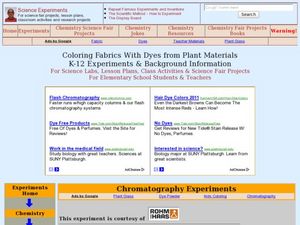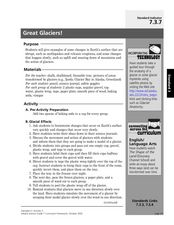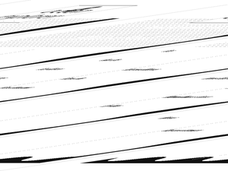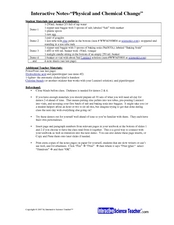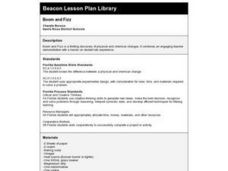Curated OER
Air, Air Everywhere! Lesson 2: Acid Rain
Middle school environmentalists record the pH of four different liquids, including two aerosol cleaning products. They liken the products to acid rain and speculate in writing which might affect the human respiratory system. Although...
Curated OER
Acids and Alkalis
This PowerPoint progresses slide-by-slide through all the facts you would want to deliver about acids, alkalis, salts, and the related lab tests. Each slide has one or two facts about a physical or chemical property or behavior. The...
Curated OER
Terrestrial Sequestration- Photosynthesis and Cellular Respiration
Students examine the differences between cellular respiration and photosynthesis. In this cellular processes lesson students complete a group lab activity to see how climate change affects their lives.
Curated OER
Cabbage Juice Indicator
Students experiment with household solutions and classify them as a base or acid. For this exploratory lesson students complete a lab where they test products to see if they are an acid or a base.
Curated OER
Scientific Method "Lab Writeup"
Students analyze and experience the scientific method. They discuss the various steps of the method, conduct various experiments, and write a three-paragraph essay regarding their conclusion.
Curated OER
Geologic Sequestration
Students investigate how geologic sequestration reduces carbon dioxide concentration in the atmosphere. In this earth science lesson plan, students simulate oil mining in the lab. They write down their observations and complete the lab...
Curated OER
Oceanic Absorption- Oceanic Sequestration
Students examine the different techniques that may be used to reduce carbon dioxide in the atmosphere. In this ocean pollution lesson students divide into groups and complete a lab to see how the ocean holds carbon dioxide.
Curated OER
Coloring Fabrics With Dyes from Plant Materials K-12 Experiments & Background Information
Young scholars investigate the effects of acid and bases on dyes made with plant materials. In this chromatography lesson students predict color outcomes and complete a lab activity on color combinations.
Curated OER
Great Glaciers!
Seventh graders study the earths surface and how changes happen to it. In this glacier instructional activity students complete a lab activity to see how glaciers form.
Curated OER
Volcanoes
Students explore the formation of volcanoes. In this earth science lesson, students build their own volcanoes in the lab using different materials. They identify the different types of volcanoes.
Curated OER
The pH scale
Students list the common properties of acids and bases. They classify substances as acids or bases, by using pH and litmus tests and are able to explain the pH scale. They participate in a lab activity which reinforce their understanding.
Curated OER
What is a Karst?
Students examine the process that creates limestone. In this limestone lesson students complete a worksheet and participate in a lab activity.
Curated OER
Ocean Absorption Lab
Learners examine various techniques that can reduce carbon dioxide in the atmosphere, and use chemistry to simulate oceanic sequestration. They conduct an experiment involving the method of oceanic absorption for carbon sequestration,...
Curated OER
Geo Sequestration Lab
Students explore geologic sequestration as a technique used to reduce carbon dioxide in the atmosphere. They use chemistry to stimulate oil mining. Students conduct an experiment to learn about geo carbon sequestration.
Curated OER
CO2 and Mass
Students determine if carbon dioxide has mass. In groups, they use a standard set of materials to test the carbon dioxide. They answer questions on their lab sheet and discuss them as a class.
Curated OER
Physical and Chemical Change
Students study the differences between physical and chemical changes. In this physical and chemical lesson students complete several labs to help them to see the differences between these changes.
Curated OER
Relationships and Biodiversity
Learners examine diversity on the planet and the differences within a species. In this investigative lesson students complete a lab that allows learners to better understand the relatedness between plants.
Science Matters
Forms of Energy
The amount of energy Americans use doubles every 20 years. The first lesson in a 10-part series teaches scholars about different forms of energy. They rotate through five stations with hands-on activities or experiments at each in order...
Integrated Physics and Chemistry
Law of Conservation of Matter
Does mass change during a chemical reaction? Demonstrate the Law of Conservation of Matter while encouraging class members to be creative with a two-part lesson. First, learners use Alka-Seltzer® tablets and water to demonstrate the...
Curated OER
Terrestrial Sequestration - Photosynthesis and Cellular Respiration
Students investigate how plants absorb carbon dioxide during photosynthesis. In this biology lesson, students differentiate photosynthesis and cellular respiration. They discuss the important role of plants in the environment.
Curated OER
Bringing The Greenhouse Effect Down To Earth (CO2 experiment)
Students compare 4 different form of carbon dioxide and discuss the role that carbon dioxide has in the Greenhouse Effect. They then understand that the Greenhouse Effect is a naturally occurring event.
Curated OER
How Can You Tell One Clear Gas From Another?
Fifth graders perform experiments to determine the identity of an unknown gas sample. In this chemistry lesson, 5th graders fill balloons with air, oxygen, hydrogen, and carbon dioxide. They use mass and reactivity to identify the gases.
Curated OER
Boom and Fizz
Young scholars investigate the differences between a physical and chemical change. They observe various demonstrations involving physical or chemical changes, make predictions, and record what they see, hear, and smell.
Curated OER
The Nature of Chemical Change: Acting Out An Example
Students illustrate the molecular nature of matter and show that chemical change involves alteration of molecules.









